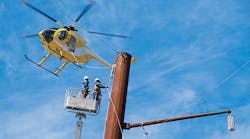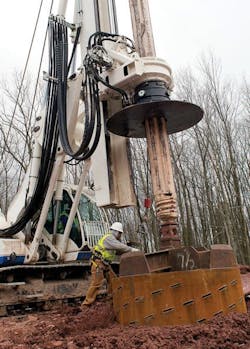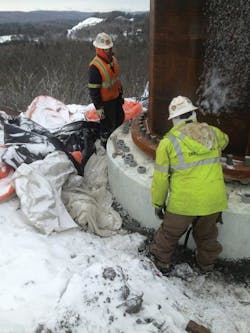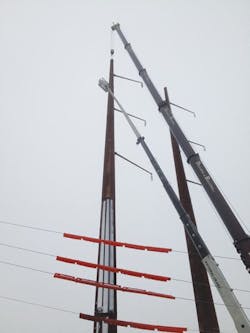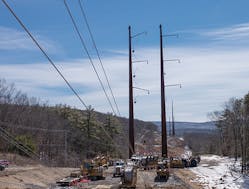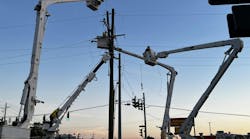After three years of construction over a 146-mile route in Pennsylvania and New Jersey, and the installation of hundreds of steel poles that will improve reliability for millions of electricity users in the northeastern United States, the 500-kV Susquehanna–Roseland transmission project was energized, quietly, on May 11 with the click of a transmission operator’s mouse.
Representing a major upgrade to the nation’s electric grid that will make electric service more reliable long into the future, the power line extends from the Susquehanna nuclear power plant near Berwick, Pennsylvania, to Roseland, New Jersey, passing through several new or upgraded substations along the way.
The Susquehanna–Roseland project, which replaced a 1920s-vintage 230-kV line, will benefit customers throughout the region by strengthening the grid and preventing overloads on other transmission lines.
Recognizing a Critical Need
Planning began 10 years ago when PJM Interconnection determined that a new high-voltage line was needed to prevent other transmission lines from becoming overloaded. The regional grid operator directed PPL Electric Utilities to build the 101-mile Pennsylvania part of the line and Public Service Electric and Gas Co. to handle the 45-mile New Jersey side.
Building a major transmission line takes expertise in construction and project management, but it also involves knowing how to seek and incorporate public input, how to work cooperatively with multiple permitting agencies, and how to minimize impacts on people and the environment. As such, the Susquehanna–Roseland line will serve as the model as PPL Electric Utilities plans future transmission projects to benefit consumers.
The Obama administration named the line to the initial list of projects for its Rapid Response Team for Transmission, recognizing the critical nature of the infrastructure upgrade and the complex web of government permits that the companies needed to navigate.
Taking on Challenges
Everything about the Susquehanna–Roseland project took on large proportions, from the miles of new line to the substation construction and upgrades, to the monumental task of coordinating demolition and construction through two states, to the protection of sensitive environmental areas along the route.
Among the challenges: passing through three sections of national park land on existing rights-of-way. It required extensive review by the National Park Service and resulted in a groundbreaking mitigation agreement that will enable the park service to use $66 million to expand its landholdings in the area, enhance historic structures, improve wetlands and make other improvements to benefit recreational users and the public as a whole.
As a result, PPL Electric Utilities worked successfully with the park service and other parties to demonstrate its commitment to environmental compliance, and safe and effective construction techniques. The park service review required an environmental impact statement, which included scientific study and its own public input process. That kind of outreach was a hallmark of the Susquehanna–Roseland project. PPL Electric Utilities organized 25 public open houses to gather public input on the project and make changes wherever possible to minimize impacts.
Routing the Line
PPL started the siting process by selecting three possible routes for the line in Pennsylvania. The open houses were held when the three alternate routes were announced and again after the proposed route was selected. The public comments on each alternative supplemented the extensive siting process, which looked at geographic, environmental and demographic factors for each potential route.
Ultimately, PPL chose the route that would best minimize impacts to people and the environment while still being feasible and meeting the project’s electric reliability goals. The companies would use existing transmission rights-of-way for more than 90% of the route.
Whether it involved securing environmental permits or interacting with special interest groups opposed to the power line, PPL Electric Utilities found that challenges were overcome by engaging openly and honestly with everyone. The utility adhered to a strong commitment to meet every term of every environmental permit, while emphasizing that the line was needed to strengthen the nation’s power grid and provide strong benefits to customers.
Stimulating the Economy
In addition to improving reliability, the project, which created about 2,000 jobs during its construction, has received attention for its economic benefits and its more than $1 billion stimulus to the regional economy.
The Pennsylvania portion required 525 steel poles weighing a total of 25,000 tons, 912 miles of conductor, 185 miles of fiber-optic ground wire, 48,000 cubic yards of concrete and 1.75 million man-hours to build.
“Infrastructure and work force will drive job growth and investment within the United States for the foreseeable future,” said Jeffrey Box, president and CEO of Northeastern Pennsylvania Alliance, a regional community and economic development agency.
A strong, modern electric delivery network is necessary to the cost-effective delivery of energy and is absolutely critical to successful economic development, Box commented.
“This is particularly true in regard to electric service as our reliance on electronic technologies and the emphasis on clean energy grows through the first half of this century,” he said. “The Susquehanna–Roseland power line project will benefit all of us by providing a more secure, more up-to-date and more efficient system of delivering electric service to the region.”
Strengthening the Grid
Chuck Leonard, executive director of the Pocono Mountains Economic Development Corp., noted that the nation’s system of electric service delivery faces significant challenges as the demand for power continues to increase.
“Areas with excellent electric service will retain a competitive advantage in the near and long terms,” he said. “The Susquehanna–Roseland line has strengthened the security of our most important utility service and is a critical component necessary to the region’s prosperity.”
From its economic benefits to helping strengthen the nation’s grid, the Susquehanna–Roseland project provided satisfaction on many fronts. For example, building relationships with contractors, landowners, and regulatory and environmental agencies, and meeting its commitments on safety, budget and schedule all contributed to a successful project.
While the new transmission line in the utility’s service territory is significant in stature, so was the effort put forth by the large number of people involved in the job. When the managers look at the finished product, they not only see the physical work that was performed, but also the meetings and paperwork that went into its completion and the faces of all the people who played a part in its success.
Stephanie R. Raymond is vice president of transmission and substations for PPL Electric Utilities. Raymond leads an organization of 300 people that has embarked on the largest-scale infrastructure investment since the 1960s and 1970s. Raymond joined PPL Electric Utilities in 2011 as director of project and contract management. In addition to transmission and substation operations, her department is responsible for planning, engineering, compliance, real estate, siting and permitting, project management, construction management and contract management for the utility. Raymond earned a bachelor’s degree in business administration from California State University in Sacramento and completed the Stanford Graduate School of Business Executive Education Program.
Tim Howell is PPL Electric Utilities’ construction manager for the Susquehanna–Roseland transmission project. He started in the construction department at PPL Electric Utilities in 1980 and was promoted to foreman in 1985. In 1988, he joined PPL’s safety and training organization for the construction department, and in 1995, he became a production supervisor for transmission and substation work. He also served as regional manager of the mobile workforce for the Lancaster and Harrisburg regions, with responsibility for all substation, transmission and distribution work performed by internal resources and contractors. Howell earned a bachelor of science degree in industrial technology from Millersville University.
